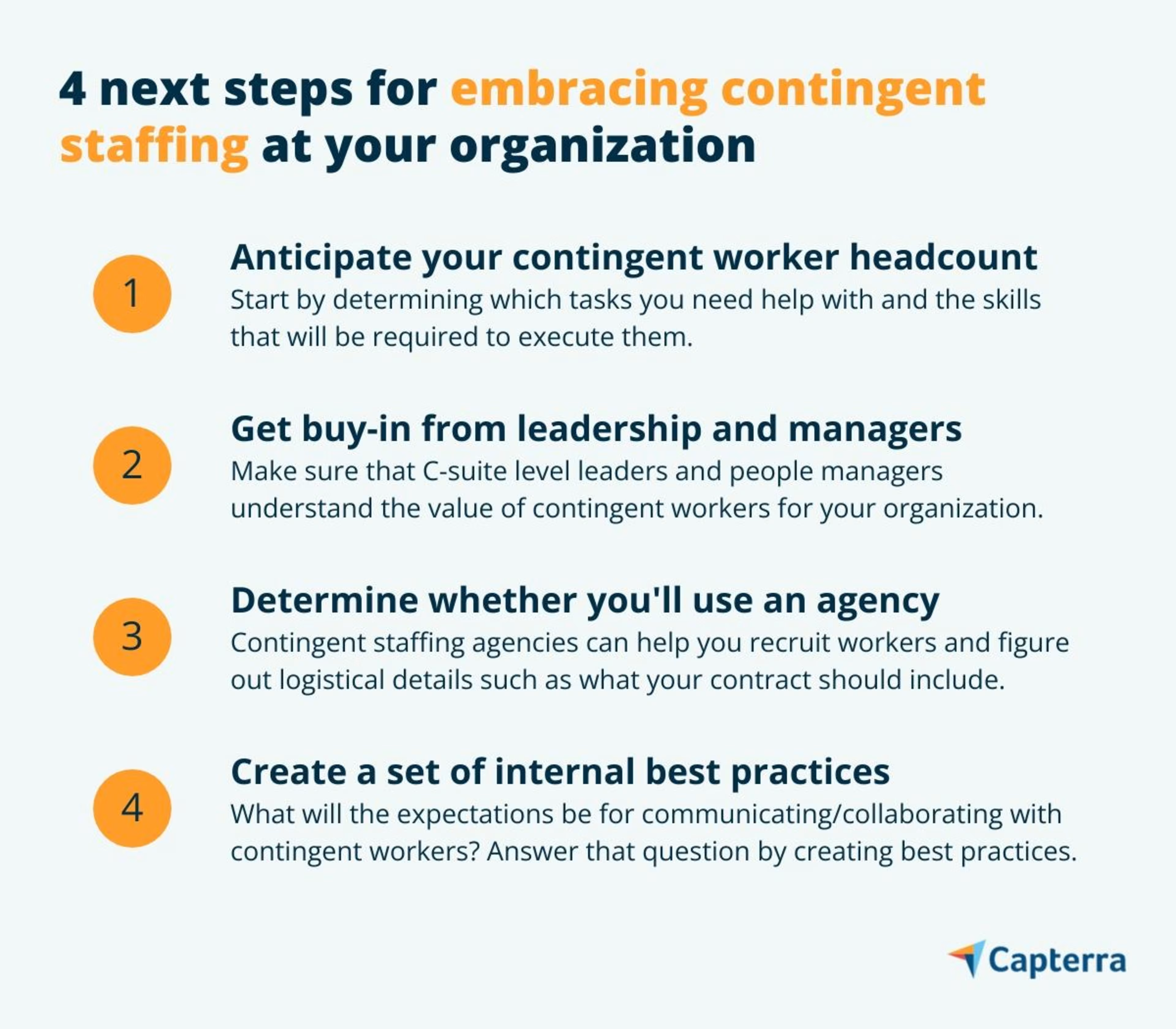Make an informed decision about whether contingent staffing is right for your organization by digging into the two essential considerations below.
In a Capterra survey conducted last year, we polled over 300 employees with recruiting responsibilities and found that 56% fear there are job openings that their employer will never be able to fill.
With that in mind, it’s no wonder why hiring managers and business owners are looking for ways to fill open seats quickly. And one of the best ways to do that? Contingent staffing.
Contingent staffing is a hiring strategy that’s often used to fill skill gaps or get through a period of increased demand for labor. When used appropriately, your business can benefit through cost-savings and an agile workforce, but it’s not always the best solution to your understaffing problems.
If you’re a hiring manager or business owner tasked with determining whether contingent staffing is a good option for your organization, this guide is for you. We’ll help you navigate this decision by providing examples of industries that commonly use contingent workers to a formula for comparing the cost of hiring a full-time employee to that of a contingent worker.
What is contingent staffing?
Contingent staffing is a hiring strategy wherein temporary workers (also called contract workers or consultants) are hired to supplement a company's permanent workforce. Typically, a contingent worker is brought on to help with a specific project or season of work, although it’s not uncommon for contingent workers to commit to 12-, 18-, or 24-month contracts.
Having a contingent workforce is more common in some industries than others, and there’s good reason for that: Industries whose demand for service ebbs and flows or who execute on projects (rather than a steady stream of work) benefit more from the help of temporary employees.
Some examples of industries that commonly use contingent works are:
Healthcare: Businesses such as hospitals, clinics, wellness centers, assisted living centers, and home health care providers rely on contingent workers to fill skill gaps quickly. This practice has become more prevalent than ever due to healthcare personnel shortages exacerbated by the COVID-19 pandemic.
Manufacturing: Food and beverage manufacturers, as well as apparel, electronics, coal, plastics, and automotive manufacturers use contingent workers because production supply and demand frequently fluctuate, and the acquisition of contingent labor can be adjusted.
IT: Businesses of all kinds may choose to contract contingent workers with IT experience to work as computer network support specialists, installing new hard- or software, troubleshooting problems, and conducting routine maintenance (such as performing file backups on the network).
Construction: Construction firms may bid on a project that requires more labor than they have readily available, or in some cases, a specialized set of skills. For example, a general contracting firm that bids on a renovation project may discover mold or fire damage in the course of their work, in which case they would need temporary assistance from a restoration expert.
What are the differences between a contingent worker and a full-time employee?
In the eyes of the law, there is a notable difference between full-time, permanent employees, and contract workers. We’ll cover three of the most important differences below.
Compensation: Full-time employees earn an annual salary, while contingent workers are paid an hourly wage for the work they perform. Meaning, employees are on your payroll, while contingent workers are not. Also, contingent workers do not receive benefits provided to full-time employees (such as insurance or PTO), although they are entitled to minimum wage and overtime pay.
Work hours: While employers can request a full-time employee work within certain set hours, the same cannot always be said for contingent workers. In most cases, contingent workers set their own hours and schedule, although there are exceptions, such as if a contingent worker was hired to replace a full-time employee while they’re on parental leave.
Oversight: Contingent workers have more flexibility than full-time employees when it comes to work completion. Misclassification of employees is a risk with hiring contingent workers, and one of the factors an employer must be able to prove in order to classify a worker as contingent is that the worker is free from control and direction in the performance of services. This means that employers can exercise more control over full-time employees than contract workers.
The benefits of contingent staffing for employers
There are two main factors that motivate companies to opt for contingent labor: First, the opportunity to cut fixed costs, and second, the staffing flexibility that contingent workers provide.
Cost-savings
In a recent survey from Gartner, 32% of respondents stated that their employer was replacing full-time equivalent (FTE) employees with contingent workers as a cost-savings measure (full content available to clients).
In many cases, hiring a contingent worker is a fraction of the cost of hiring a new, full-time employee. This is because full-time employees are provided with costly benefits in addition to their salary, such as insurance, matching 401k contributions, and paid time off. Employers are also required to pay U.S. Social Security and payroll taxes for full-time employees, while that’s not the case for contingent workers (unless local laws say otherwise).
Greater staffing flexibility
Utilizing contingent workers gives employers the ability to adjust their workforce based on business needs. For example, contingent staffing is very common in the construction industry, where the demand for workers depends on how many ongoing projects a firm is involved in and the scope of those projects.
Plus, it’s much faster to fill open roles or skill gaps with contingent labor rather than full-time employees, because contingent workers arrive with the skill-sets needed, negating the need for a lengthy training or onboarding process. In most cases, employers use a contingent staffing firm to help them find temporary workers. Because these firms have access to a pool of talent to choose from, your recruiting process will be limited to screening candidates sent from your staffing partner.
Of course, there are other benefits, and more importantly, drawbacks, of contingent workers to consider. For an overview of the pros and cons of contingent workers, check out this short video:
How to determine if contingent workers are right for your business
When it comes down to it, there are two essential considerations to keep top of mind when trying to decide if you should hire a contingent worker or a new employee:
The kind of work you need additional help with.
Whether you’ll actually save money by hiring contingent labor.
Answering these questions will require some strategic thinking, but don’t worry—we’ll add context that helps you understand why these considerations are so crucial and provide recommendations that will help you navigate your way through this decision. Let’s start with the first consideration: the kind of work you need help with.
First, define the scope of the work you need help with
Earlier, we gave examples of industries that commonly use contingent labor. Each of these examples reaffirms something else we mentioned: that companies use contingent workers because of the flexibility they provide.
With that in mind, your next step is to define the scope of the work you need help with. Determine whether it’s a routine task or process that’s a part of your business’s operations or a one-off assignment. If it’s the former, you'll be better off opting for a full-time employee rather than a temporary one, although there are some exceptions to this. For example, retailers may need help with a routine task (such as packaging online orders) that’s seen a spike in demand due to the holiday shopping season.
Next, anticipate the level of involvement you’ll need to have in the work
Contingent workers cannot be managed the same way full-time employees are. And if an employer exercises too much control over how a contingent worker completes their duties, they risk misclassification—the legal and business consequences for which can be costly.
Thinking of building a contingent workforce? Check out Baker McKenzie’s Contingent Worker Misclassification Risk Map & Comparison Tool.
This means that if the nature of the work you need help is highly specific to your business, it’s probably best to hire a full-time employee who can be trained on the nuances of the job. On the other hand, if the work is straightforward and can be completed without much oversight or interference from your team, a contingent employee could be a great solution.
Lastly, compare the cost of a contingent worker vs. a full-time employee
The most important consideration for whether you should embrace contingent staffing or not is how it will affect your bottom line. In “Increasing the Contingent Workforce Requires Planning of Costs and Activities,” Gartner gives an overview of all the costs associated with hiring contingent employees (full content available to clients).
The math
According to Gartner, the cost of hiring a full-time employee can be calculated by totaling the costs of recruiting efforts, employee contributions to benefits (typically, an additional 20% to 40% equivalent of their base pay), wages, and training.
The same formula can be used to determine the cost of hiring a contingent worker, but in most cases, you won’t contribute to their benefits and recruiting costs will be limited to fees charged by a staffing solutions company. Plus, training costs will be lower because contingent employees are usually hired with the know-how needed to complete their work.
You might be thinking that this means hiring a contingent worker will be much more affordable than hiring a full-time worker, but contingent workers are responsible for covering their own benefits and paying their own taxes, which means they usually have a wage rate that is 20% higher than that of a permanent employee.
With all of this in mind, you should calculate the potential costs of hiring a full-time employee and a contingent worker and compare the two in order to determine which option makes the most sense for your business.
Establish a game plan for hiring contingent staff
Gartner research from 2020 revealed that 83% of organizations expected to increase their use of contingent workers (full content available to clients). Since that research was published, the talent shortage has only escalated. Contingent workers may be a solution since they are quick to hire and can start executing on work that’s not getting done due to open positions recruiters are struggling to fill.
If after reading this guide you believe that contingent workers might be a good fit for your organization, you can get started by following the four steps outlined in the graphic below:


